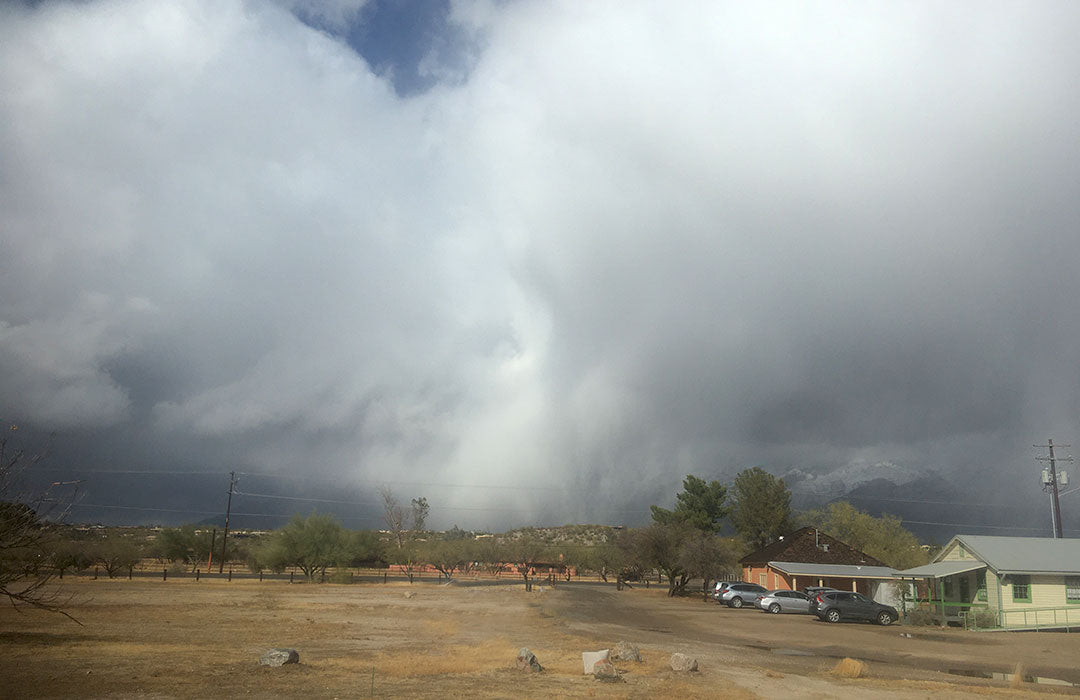
by Joel Johnson, Seed Production Technician
After several weeks in the upper 70s, a late January snow on the Santa Catalinas reminded us that we really did have a winter! Now we’re back to blue skies and spring sprouts. Lots of changes are taking place in the Conservation Center grow-out gardens—new varieties are being regenerated, new building projects are going up, and new faces are helping us make it all happen.
Beans

Many of our beds are filled with beans or pulse crops. This winter, we’re growing two garbanzos—a larger planting of Garbanzo Del Norte and a smaller regeneration of Mayo Winter Bean. Several beds are full of Tarahumara Pinks, a lentil variety, and Tarahumara Chicharos, a garden pea. Spanish peas are growing rapidly in the courtyard, which is especially encouraging since this variety was last grown out in 1989! Favas round out the bean plantings: Tarahumara Havas and Havas del Norte both sprouted the first week of February. (pictured above: Garbanzo del Norte)

DiMeglio Arugula is a low-desert favorite, so three different plantings will help us meet distribution demand. The plants that self-seeded from last spring’s seed harvest are well ahead of the winter planting; bees were pollinating these arugula flowers by the end of January. The javelina in our area had a taste for Magdalena acelgas last season, so this spring it is enjoying the safety of a second layer of fencing. (pictured above: DiMeglio Arugula)
And Other Things



I'itoi Onions are one of the most requested items in our Native American Seed Request program, so they fill up most available nooks and crannies throughout the garden beds. We also have a good stand of Purple Queen garlic maturing. We hope to recover a previous grow-out that resulted in fragile skins when drying. The plastic sheeting shown is being used to solarize the roots of our winter cover crops after they were mowed down. The roots will break down in place, adding organic matter to the soil and we will plant spring corn straight through the cover crop stubble in mid-February. (pictured above l to r: I'itoi Onions, Purple Queen Garlic, Solarizing Tarp)
Garden Expansion

In December, we added 6 long beds, bringing nearly 1,500 square feet of new growing space into production. Those beds are now outfitted with drip irrigation and seeded with Spanish Bearded Barley, I’itoi’s onions, and a soil-building mix of cool-season cover crop. 7 additional smaller beds were also added, including the installation of two more pollination tents. These are protecting Mostaza Roja mustard, Quelite chenopodium, and Swain Heirloom dill from crossing with wild varieties on the property. (pictured above: Expanded garden area)
Composting Bioreactors
Salinity, alkalinity, and low organic matter, are some of the hallmark challenges of desert soil. Fungal communities have been found to aid all three of these aspects by tying up salts, making insoluble nutrients like phosphorus more available, and helping break down organic matter into humus. Dr. David Johnson of NMSU and his wife Hui-Chun Su developed the Johnson-Su Composting Bioreactor to produce high-fungal compost for desert soils with minimal labor and cost. Materials have been on back-order for most of last year, but we finally received the pieces we needed. We’re excited to build our first bioreactor next month and hope to build more in the future to support our soils and grow-outs.
Fence Project
We are also moving forward with construction of a hog fence to prevent javelina from entering the Conservation Center property along Alvernon Road. This is the final portion of fencing needed to exclude javelina, which were the most destructive pests to our seed crops last year. Having this installed before spring crops reach maturity will provide much-needed protection. Thank you Pat McNamara of Tres Saguaros for tackling the trenching for us!
----------------------------------------------------------------------------------------------------------
If you’re interested in volunteering in the grow-out gardens at our Tucson Conservation Center, please reach out to jjohnson@nativesseeds.org. There’s lots of work still to be done!
Unable to volunteer but still want to support? Check out items on our "Garden Wishlist" If you order from the list items will be shipped directly to the Conservation Center. Donate Goods for the Garden from the Wish List>>
